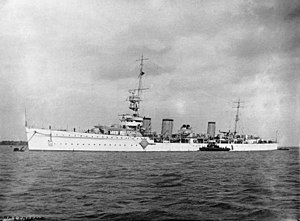HMS Emerald (D66)
 Emerald at anchor
| |
| History | |
|---|---|
| Name | Emerald |
| Builder | Armstrong Whitworth, Newcastle-on-Tyne |
| Laid down | 23 September 1918 |
| Launched | 19 May 1920 |
| Commissioned | 14 January 1926 |
| Decommissioned | 9 June 1948 |
| Out of service | 15 July 1933 |
| Reclassified |
|
| Identification | Pennant number: D66 |
| Fate | |
| General characteristics | |
| Class and type | Emerald-class light cruiser |
| Displacement | |
| Length | 570 ft (173.7 m) |
| Beam | 54.5 ft (16.6 m) |
| Draught | 16.5 ft (5.0 m) |
| Installed power |
|
| Propulsion | 4 shafts; geared steam turbines |
| Speed | 33 knots (61 km/h; 38 mph) |
| Range |
|
| Complement | 572 officers and ratings |
| Armament |
|
| Armour |
|
| Aircraft carried |
|
HMS Emerald was an Emerald-class light cruiser of the Royal Navy. She was built by Armstrong at Newcastle-on-Tyne, with the keel being laid down on 23 September 1918. She was launched on 19 May 1920 and commissioned 14 January 1926.
History[]
Emerald went out to the East Indies, 4th Cruiser Squadron, on commissioning, finally returning home to pay off on 15 July 1933. During her time in the far east she participated as part of a Royal Navy flotilla in the 1927 Nanking Incident, helping to protect British and other international citizens and business interests. After a refit at Chatham, the ship recommissioned for the East Indies again on 31 August 1934, which tour lasted until September 1937, on relief by Liverpool. On her return home she paid off to reserve.
Recommissioned for war service, she joined the 12th Cruiser Squadron on Northern Patrol duties in September 1939. However, the appearance of German raiders in the Atlantic resulted in her transfer to Halifax in October to escort homeward-bound convoys, where she remained into 1940. During the early part of the war, until May 1940, her captain was the noted officer Augustus Agar, V.C.. On 24 June 1940 Emerald departed Greenock carrying £58 million in gold, and reached Halifax on 1 July where the gold was transferred to a Canadian National Railway train for safe storage in Canada until the threat of German invasion of England had passed.[1] Her sister ship Enterprise shipped another £10 million for Operation Fish.
In 1941 Emerald was transferred to the Indian Ocean, where she escorted troop convoys to the Middle East and stood by in the Persian Gulf during the operations in Iraq in April 1941. After Japan's entry into the war, in December 1941, Emerald joined the Eastern Fleet as part of the 'Fast Group', and in March 1942 was flagship. In August 1942 the ship returned home to refit at Portsmouth, and did not return to service until early April 1943.
She rejoined the Eastern Fleet, 4th Cruiser Squadron, for escort duties, then returned home once more for the Invasion of Normandy, when she served with Force "K" in support of Gold Beach. By January 1945 Emerald had joined the reserve fleet and, in 1947, was allocated for ship target trials. As a result of these trials the ship foundered in Kames Bay, Rothesay, on 24 October, and was not refloated until 9 June 1948, after which she was docked, examined, and then handed over to BISCO on 23 June 1948 for breaking up. She was scrapped at Arnott Young (Troon, Scotland) where she arrived on 5 July 1948.
See also[]
References[]
- ^ Stowe, Leland (1964). Secrets & Spies. Pleasantville, New York: Reader's Digest. pp. 53–58.
Bibliography[]
- Brown, David K. (1997). "Re: E's and Super Es". Warship International. XXXIV (1): 7–8. ISSN 0043-0374.
- Brown, David K. (1987). Lambert, Andrew (ed.). "Ship Trials: Tests Against Cruisers". Warship (42): 106–108. ISSN 0142-6222.
- Colledge, J. J.; Warlow, Ben (2006) [1969]. Ships of the Royal Navy: The Complete Record of all Fighting Ships of the Royal Navy (Rev. ed.). London: Chatham Publishing. ISBN 978-1-86176-281-8.
- Friedman, Norman (2010). British Cruisers: Two World Wars and After. Barnsley, UK: Seaforth Publishing. ISBN 978-1-59114-078-8.
- McBride, K. D. (1996). "Es and Super-Es". Warship International. XXXIII (3): 257–278. ISSN 0043-0374.
- Rohwer, Jürgen (2005). Chronology of the War at Sea 1939–1945: The Naval History of World War Two (Third Revised ed.). Annapolis, Maryland: Naval Institute Press. ISBN 1-59114-119-2.
- Whitley, M. J. (1995). Cruisers of World War Two: An International Encyclopedia. London: Cassell. ISBN 1-86019-874-0.
- Woodbridge, W. D. (1997). "Re: E's and Super Es". Warship International. XXXIV (1): 8. ISSN 0043-0374.
- Operation Fish, by Alfred Draper, General Publishing, Don Mills, Ontario, Canada, 1979
External links[]
| Wikimedia Commons has media related to HMS Emerald (ship, 1926). |
- Emerald-class cruisers
- Ships built on the River Tyne
- World War II cruisers of the United Kingdom
- 1920 ships
- Ships built by Armstrong Whitworth